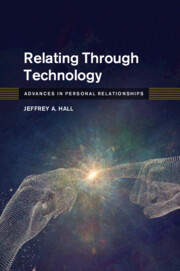Book contents
- Relating Through Technology
- Advances in Personal Relationships
- Relating Through Technology
- Copyright page
- Dedication
- Contents
- Figures
- Tables
- Introduction
- 1 Social Ecology and Personal Media
- 2 The Social Construction of Technology
- 3 Theoretical Perspectives on Personal Media and Relationships
- 4 Niche, Media Displacement, and Multimodal Relationships
- 5 Mode Comparison and Coexistence
- 6 Three Ways of Seeing Social Media
- 7 Five Enduring Tensions in Personal Media
- 8 Digital Stress
- 9 Social Displacement
- 10 Connectivity and Connection
- References
- Index
3 - Theoretical Perspectives on Personal Media and Relationships
Published online by Cambridge University Press: 26 June 2020
- Relating Through Technology
- Advances in Personal Relationships
- Relating Through Technology
- Copyright page
- Dedication
- Contents
- Figures
- Tables
- Introduction
- 1 Social Ecology and Personal Media
- 2 The Social Construction of Technology
- 3 Theoretical Perspectives on Personal Media and Relationships
- 4 Niche, Media Displacement, and Multimodal Relationships
- 5 Mode Comparison and Coexistence
- 6 Three Ways of Seeing Social Media
- 7 Five Enduring Tensions in Personal Media
- 8 Digital Stress
- 9 Social Displacement
- 10 Connectivity and Connection
- References
- Index
Summary
This chapter reviews classic theories of CMC that are relevant to understanding personal media use, including media richness theory, social presence theory, channel expansion theory, the hyperpersonal model, social information processing theory, channel complementary theory, and media multiplexity theory. The chapter also explores emergent and important perspectives, such as relationship interdependence and mundane mediated relationship maintenance. This chapter introduces the communicate bond belong (CBB) theory, which examines how the content of communication, particularly the episode of communication, influences the satiation of the fundamental need to belong. One advantage of CBB is its focus on human energy management, which stipulates that humans seek to conserve energy expenditure and invest their time and energy toward future belongingness need satiation. From the perspective of CBB theory, personal media use is understood as result of three forces: need satiation, energy conservation and investment, and homeostatic balance of social interaction and time alone.
Keywords
- Type
- Chapter
- Information
- Relating Through TechnologyEveryday Social Interaction, pp. 48 - 69Publisher: Cambridge University PressPrint publication year: 2020



